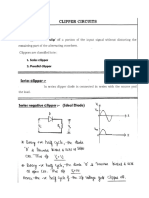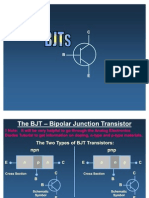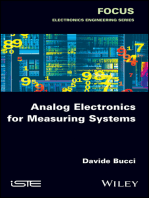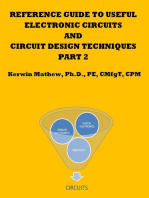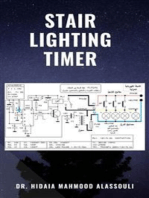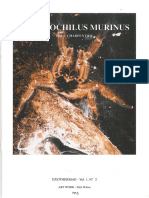83978djrcet II B.tech I Sem Edc-unit-V & Vi Notes
83978djrcet II B.tech I Sem Edc-unit-V & Vi Notes
Uploaded by
Nicholson ZapantaCopyright:
Available Formats
83978djrcet II B.tech I Sem Edc-unit-V & Vi Notes
83978djrcet II B.tech I Sem Edc-unit-V & Vi Notes
Uploaded by
Nicholson ZapantaOriginal Description:
Original Title
Copyright
Available Formats
Share this document
Did you find this document useful?
Is this content inappropriate?
Copyright:
Available Formats
83978djrcet II B.tech I Sem Edc-unit-V & Vi Notes
83978djrcet II B.tech I Sem Edc-unit-V & Vi Notes
Uploaded by
Nicholson ZapantaCopyright:
Available Formats
DEPARTMENT OF ECE
UNIT-V&VI
3mm
25 m
Construction: -
C
P
P N
Silicon diode N
C
N
1mm
5 m
0.3mm
NPN
Potential barrier at the
junctions of unbiased transistor.
Biasing.
Currents in a Transistor.
IE = IC + IB
and IC IE
ICEO = Collector current when base is open circuit
(Reverse saturation current of B C junction) A
ICEO = ( + 1) I CBO = Collector current when Emitter is open circuited
(very less current due to junction barriers) A.
DEPARTMENT OF ECE
IEO
= Emitter base reverse (biased) saturation current when collector is
open circuited.
COMMON BASE CONFIGURATION: -
Current gain() = Collector current
I
/ emitter current = C
IE
Varies from 0.9 to 0.95.
COMMON EMITTER CONFIGURATION:
Current gain
I
Collector Current
= C
( ) =
Base Current
IB
varies from 10 to 200 or 80.
COMMON COLLECTOR CONFIGURATION: Used for impedance
matching
= CC Current gain
=
Input
Similarly we can get
I E
I B
Output
ii) =
Ic I CBO
IB
iv) ICEO = (1+) ICBO
iii) I C = I B + I CEO
v) I E =
1
1
. ICBO +
. IB
1
1
RELATION BETWEEN, &
a)
We know IE = IC + IB, But IC = IE.
IE
= & IE + IB
IE - IE = IB
or IB = IE (1 - )
I
I
Dividing both sides by I c , B = E (1 - )
I C I C
DEPARTMENT OF ECE
Or
(b)
Or
Or
(1 )
or =
I E I C I B
I E
=
+
OR
= +1
I B I B I B
I B
I E I C
I
I
= + 1 OR E C = + 1
IC
IB
I C I B
1
. = 1 + or =
1+
I E
, Substituting IB = IE - IC.
I B
I E
=
by diving N & 0 on R.H.S, by IE.
I E I C ,
I E / I E
1
=
=
I E / I E I C / I E 1
Putting the value of = / + 1.
1
=
1
+1
1
+1
(or ) =
=
= +1
+1
1
+1
1
(or ) =
= +1
1
(c)
INPUT & OUTPUT CHARACTERISTICS OF CB CONFIGURATION.
DEPARTMENT OF ECE
IE(mA)
IE(mA)
VCB = IV
IE
VCB=0
4321-
0.5 0.6 VEB (VoHz)
Input characteristics.
CE CONFIGURATION
C.C.CONFIGURATION:
5mA
4mA
3mA
2mA
1mA
0mA
2 3 4 5 VCB(volt)
O/P Characteristics.
DEPARTMENT OF ECE
EARLY EFFECT OR BASE WIDTH MODULATION.
(IN CB CONFIGURATION)
As VCC made to increase the reverse bias, the space charge width between
collector and base tends to increase. This results in decrease of effective width of the
base. This dependence of base width on collector voltage is known as Early Effect. This
decrease of effective base width has three consequences.
(i)
There is less chance of recombination in base region and Ic increases causing
to increase with increase in VCB.
(ii)
The charge gradient is increased with in the base and current of minority
carries injected across emitter junction increases.
(iii) For extremely large Vcs, the effective base width becomes zero causing
voltage breaks down in the transistor. This phenomenon is called the Punch
through.
Drain
D
JFET CONSTRUCTION:
G
D
Gate
a) N Channel JFET
b) P Channel JFET
D
S
G G
Source
S
S
D
BIASING OF JFET
+
P
N
S
DRAIN CHARACTERISTICS: OHMIC REGION:- Drain current increases With drain voltage
DEPARTMENT OF ECE
PINCH OFF VOLTAGE(VP):
VDS for which maximumdrain current is there.
Further increase in VDS will not increase ID.
PINCH OFF REGION: Where drain current is saturated.
BREAK DOWN VOLTAGE: VDS where JFET breaks down
VGS cut off Where IB becomes zero, irrespective of VDS.
VP
= VGS cut off
CHARACTERISTICS OF JFET
MUTUAL CONDUCTANCE OR TRANS CONDUCTANCE OF FET (gm)
I D
when VDC kept constant.
gm =
VGS
It is the ratio of small change in the drain current to the corresponding small
change in gate voltage when drain voltage is kept constant.
VDS
( d ) =
, VGS kept constant
b)
Drain resistance
I D
VDC
c)
Amplification factor =
, ID kept constant.
VGS
Q.1) In common base connection IE = 1mA, IC = 0.95 mA calculate value of IB.
(JNTU 2000)
IB = IE IC = 1 0.95 = 0.05mA.
Q2) In a CB configuration current amplification factor is 0.90 and emitter current is
1mA. Determine base current.
= 0.9,
IE = 1mA
I
= C ;
IC = .IE = 0.9 x 1 = 0.9mA
IE
IB = IE IC
= 1 0.9 = 0.1mA.
Q3) A BJT has IB = 10 A, = .99 and ICBO = 1 A what is collector current.
Solution:
IC
= IB + (1+) I CBO
0.99
B
= 1 = 10.99
0.99 = 0.01 = 99
IC
= 99 x 10 + (1 + 99)1
= 990 + 100 = 1090 A = 1.09 mA.
DEPARTMENT OF ECE
Q4)
A transistor operating in CB configuration has IC = 2.98mA, IE = 3.0mA and
Ico = 0.01mA. What current will flow in collector circuit of that transistor when
connected in CE configuration and base current is 30A. (May,2006)
Given :
CB
=
IC = 2.98mA,
IE = 3.0mA
ICO = 0.01mA.
IB = 30 A
IC = ?
0.99
.99
=
=
=
= 99
1 1 0.99 0.01
IB + ( + 1) Ico.
99 x 30 x 10-6 + (100)0.01 x 10-3
2.97 x 10-3 + 1 x 10-3 = 3.97mA
2.98
3.0
= 0.99
IC = IB
CE
IC
=
=
=
Q 5)
Given an NPN transistor for which = 0.98, Ico = 2A IEO = 1.6A. ACE
configuration is used and VCC = 122 and RC = 4.0K. What is the min. base current
required in order that transistor enter in to saturation region.
Given = 0.98, ICO = ICB = 2A,
IEO = ICEO = 1.6A.
VCC 12 VCE = VCC = 12V,
RL = 4.0K IB = ? (In saturation)
Solution:Where Transistor is in saturation VCE = 0.2 (Assumed)
VRL = 12 0.2 = 11.8 Volts.
V
11.8
I c = RL =
= 2.95 103 = 2.95mA
3
RL 4 10
We know
Ic = IB + (+1) ICBO
0.98
.98
=
=
=
= 49
1 1 0.98 0.02
2.95 x 10-3 = 49
IB + (49+1) 2 x 10-6
2950A = 49IB +100A
49IB = (2950 100)A
= 2850 A
2850
IB
= 49 = 58.16 A
Q 6)
When a reverse gate voltage is 12V, gate current is 1mA. Determine the
resistance between gate & source.
(JNTU 2000)
R=
V
12
=
= 12k
I 1103
DEPARTMENT OF ECE
Q 7)
When reverse Gate voltage changes from 4.0 to 3.9V, the drain current changes
from 1.3 to 1.6 mA. Find the Trans conductance.
Solution:
Given
VGS = 4.0 3.9
ID = 1.6 1.3
= 0.1 V
= 0.3 mA
I D
0.3 103
gm =
=
= 3 103 mho
VGS
0.1
gm = ?
Q 8)
A FET has a drain current of 4mA. If IDSS = 8mA and VGS off = -6V. Find values
(Nov. 2001)
of VGS and VP.
Given IDS = 4 mA
IDSS = 8mA
VGS off = - 6V.
Solution: (i)
VP
(ii)
= VGS off
V
I DS = I DSC 1 GS
VP
V
4 10 = 8 10 1 GS
6
-6V = 6V.
=
2
V
1 VGS
1
= 1
or
= 1 GS
2
6
6
2
(or )0.707 = 1
or
(or )
VGS
6
VGS
6
= 1 0.707 = 0.293
VGS = 6 0.293 = 1.758Volts.
SATURATION DRAIN CURRENT (IDSS)
2
2 I DS I DSS
V
I DS = I DSS 1 GS g m =
VP
VP
gmo is gm when VGS = 0
g mo =
V
2 I DSS
andg m = g mo 1 GS
VP
VP
DEPARTMENT OF ECE
COMPARISON OF BJT AND FET
1)
FET is uni polar device current ID is due to majority (Where as BJT is
Bipolar) charge carries only.
FET is less noisy as there are no junctions(in conduction channel) FET
2)
3)
4)
5)
6)
FET Input impedance is very high (100 m) (due to reverse bias)
FET is voltage controlled device, BJT is current controlled device
FETs are easy to fabricate
FET performance does not change much with temperature. FET has Ve
temp. Coefficient, BJT has +Ve temp. coefficient.
FET has higher switching speeds
FET is useful for small signal operation only
BJT is cheaper than FET.
7)
8)
9)
MOS FET (Metal Oxide Semiconductor Field Effect Transistor)
N regions are highly doped
P regions are lightly doped.
Both N regions (D & S) are repeated by 1 mil. (10-3 inch) or So.
A thin insulating layer is over the surface. This is Si 02 ( a metal oxide) layer that
curves entire channel region given and a gate of metal (AP) is formed over the Si 02
layer.
Biasing: D
Gate is kept positive w.r.t source. And
attracts electrons (or induces negative
Charge in the channel opposite to
gate) This region acts like a capacitor
with Si02 layer acts as insulator between
two plates of the capacitor.
S
Due to this induced negative region a temporarily N Channel is created from
Drain to source or N channel is enhanced. Therefore it is called as Enhancement
MOSFET.
Gate leakage current is in the order of 10-12 Amps. Hence input impedance is very
(1010 to 1015 ohms).
DEPARTMENT OF ECE
Depletion Mode.
N channel exists.
Gate is kept negative wrt source.
Volt Ampere characteristics of MOSFET (or) Output characteristics of MOS FET
Precautions of Handling MOS FET
-
MOS FET may be damaged due to high voltage or static change. Thin Si02 layer get
damaged which is between Gate and Channel.
Static voltage up to 300V may develop across a man if he uses high resistance soled
shoes.
MOS FET are protected by shorting ring that is rapped around all the four terminals.
Technician handling the MOS FET are required to use shorting strap to discharge
static charge.
Q)
Explain the working principle of UJT with its characteristics
Unit Junction Transistor Symbol Equivalent Circuit
(May 06, 07).
It has only one PN junction. Therefore it is called as Unit Junction Transistor.
Arrow indicates direction of convectional circuit
Inter Base resistance (RBB) = RB1 + RB2.
10
DEPARTMENT OF ECE
RBI
and ranges from 0.56 to .75.
RB1+ RB 2
Voltage drop across RB1 = VBB which reverse biases PN junction.
Intrinsic stand off ratio =
Working Principle
-
UJT remains cut off till emitter voltage is greater than VBB.
When VE > VBB, large number of holes are injected into the N region.
These holes are repelled by terminal B2 (being +Ve biased) and collected by
B1 .
Accumulation of holes in E to B1 region reduced the resistance in this section
leading to increase in current IE.
UJT has a stable firing voltage VP = VBB + Vd = voltage across RB1 + Vd.
(RB1) / (RB1 + RB2) . VBB.
11
DEPARTMENT OF ECE
UJT RELAXATION OSCILLATOR.
Ve
Saw tooth wave
VV
0
-
T1 T2
UJT is used to generate
saw tooth waveform
VBB
R1 and R2 are external
resistors(not RB1 & RB2)
By changing CE and RE
we can change the frequency
VB2
of oscillation.
t
VC = VBB 1 e RE CE
RE CE
VP = VBB = VBB 1 e
VB1
or n = 1 e RECE , taking log e both sides t = RECEloge(1/1-n)
or t = 2.303 RECE log10 (1/1-n)
12
T3 T4
DEPARTMENT OF ECE
1
Frequency of Oscillation f = =
t
Q1)
1
1 n
A silicon UJT has an inter base resistance RBB = 10k and RB1 = 6k with
(Dec.2003)
IE = 0. If VBB = 20V and VE < VP find UJT current (c) and VP
2.3RE CE log10
VBB
20
=
= 2mA
RBB 10 K
VP = VRB1 + Vd = 6K x 2mA + 0.7V = 12.7Volts
RBB = 10K; T current (c) =
Q2)
If = 0.8 and VBB = 15V and Vd = 0.7V, find the value of VP. (June 2005)
Solution:
VP = VBB + Vd = 0.8 x 15 + 0.7 = 12.7 Volts
Q 3)
A UJT has a firing potential of 20V. It is connected across the capacitor of a
series RC circuit with R = 100K and C = 1000 Pf supplied by a source 40V DC.
Calculate the time period of saw tooth wave form generated.
Solution: -
Or
t
VC = VBB 1 e RC
VC = 20V, VBB = 40V, R = 100K, C = 1000Pf.
t
1
t
5
12
20 = 40 1 e10 100010 or = 1 e 4
10
2
4
4
1
or
= 1 e10 t
e 10 t = 1 1 2 = 1 2
2
104 t log ee = log e1 2or 104 t = 0.693
0.693 .693 106
=
t=
sec = 69.3 sec.
104
104
13
DEPARTMENT OF ECE
SILICON CONTROLLED RECTIFIER:
1) Iit is a four layer three
Terminal device
Construction
Anode (A)
Symbol
A
P1
2) Leakage current in silicon is
very small compared Germanium
N1
P2
N2
Cathode
a)cut off region
b)negative Resistance region
Biasing of SCR.
CHARACTERISTICS OF SCR.
3)
4)
SCR acts as a switch when it is forward biased.
When gate is open i.e., IG = 0, and anode voltage is applied junctions P1 N1 and
P2 N2 are forward biased where N1 P2 is reverse biased. Only small reverse
current flows.
5)
If we increase anode voltage further, at one stage anode current increases
suddenly and voltage across the SCR falls to holding voltage VH.
6)
Once SCR fires (conducts), it will remain in conduction till the current through
the device is reduced less than IH, adding current by reducing applied voltage (to
less than holding voltage) close to zero.
14
DEPARTMENT OF ECE
7)
The firing angle can be varied by varying the Gate voltage. With very large
positive (gate current break over may occur at very low voltage and SCR works as
if it is a normal PN diode.
TWO TRANSISTOR VERSION OF SCR.
-T1 is PNP and T2 is NPN.
Ib1 = IA Ie1 = IA - 1 IA = IA(1 - 1)
Ib1 = Ic2 and Ic2 = 2Ik
Ib1 = IA(1 - 1) = 2IK
(1)
(2)
(3)
We know Ik = IA + Ig. ( IA = IC1 + Ib1)
(4)
Putting the value of Ik from eqn. (4) in eqn. (3)
IA(1 - 1) - 2(IA + Ig)
IA(1 - 1) = 2(IA + Ig)
2 I g
IA(1 - 1 - 2) = 2 Ig. Or
I A =
-(5)
1 ( 1 + 2 )
Equation 5 indicates that if(1 + 2) = 1, IA =
-
SCR is also called as Thirster
Latching current (IL) the min. current required to fire the device
Holding current (IH) min. current to keep the SCR conductivity
PIV
Voltage safety factor V f =
2 RMS of operating voltage.
Value of Vf is 2 to 2.7.
15
DEPARTMENT OF ECE
SCR Half wave Rectifier.
SCR does not conduct during negative half cycle (like normal PN diode)
Firing angle depends on gate voltage
Conduction angle is ( - )
Average DC output
1
Vav =
Vm sin wt.dwt
2 0
1
2
1
=
2
1
=
2
V
= m
2
=
[ Vm cos wt ]0
[ Vm cos cos ]
Vm ( 1 cos )
(1 + cos )
1/2
RMS VOLTAGE:
VRMS is given by VRMS =
16
Vm 1
( + sin 2 )
DEPARTMENT OF ECE
SCR FULL WAVE RECTIFIER
VDC =
Q)
Vm
(1 + cos )
An SCR FWR is connected to 250V. 50 Hz mains to supply ac voltage to resistive
load of 10 for firing angle of 90. Find DC output voltage and load current.
(May, 2000)
Solution: Given
VRMS = 230V, RL = 10,
VDC = ?
IL = ?
V max
VRMS =
2
V
VDC = m (1 + Cos )
= 90
17
DEPARTMENT OF ECE
Or
Vmax = VRMS 2 = 2502 = 353.6 volts
353.6
(1 + cos 90 ) = 112.6volts
IL =
Q 2)
VDC 112.6
=
= 11.26 Amps
RL
10
A sinusoidal voltage V = 200 sin 314 t is applied to an SCR whose forward break
down voltage is 150V. Determine the time during which SCR remain off.
(Dec. 2001)
Solution: Given V1 = 150V,
W = 314
V1 = Vm sin
Vo
Vm = 200V
=? t=?
or sin =
Vm
V1
V1 150 3
=
=
Vm 200 4
= sin 1 3 / 4 = 48.6
T = 1/f
f = ? w = 2f = 314
T= 1/50 = 0.02sec = 20 m. sec.
t = T 360
= 20 48.6
360 = 2.7 m sec
or
t
f = 314/2 = 50Hz.
Q 3) A half wave rectifier employing SCR is adjusted to have a gate current of 1mA
and its forward breakdown voltage is 150V. If a sinusoidal voltage of 400V peak is
applied, determine.
i)
iii)
iv)
Firing angle
(ii)
Average output voltage
Average current for a load resistance of 200
Power output.
(Nov. 2002)
Given
V1 = 150V, Vm = 400V, = ? VDC = ? IDC = ? PDC = ? RL = 200
Solution: V1 = Vm sin, or Sin = V1 / Vm = 150/400 = 3/8 = 0.375.
= Sin-1 0.375 = 22.
V
400
400
VDC = m (1 + cos ) =
(1 + cos 22) =
(1.927) = 122.6volts
2
2
2
V
122.6
I DC = DC =
= 0.613 Amps.
RL
200
PDC = VDC .I DC = 122.6 0.613 = 75.15Watts.
18
DEPARTMENT OF ECE
Color
Construction
Typical FWD Voltage (V)
Amber
Al In Ga P
2.1
Blue
Ga N
5.0
Green
Ga P
2.2
Orange
Ga As P
2.0
Red
Ga As P
1.8
White
Ga N
4.1
Yellow
Al In Ga P
2.1
_________________________________________________________________
-
Reverse break down voltage of LED is very less 3 to 5 volts
LEDs are used for displays, including seven-segment display.
PHOTO DIODES:
Biasing
P
Symbol
Photo diode is always reverse biased
When light falls on reverse biased junction, electrons are liberated and an EMF is
available at the terminals, which leads to current through external load.
W = hf Joules
1 Lumen = 1.496 x 10-10 watts
Current will be zero only for a
positive voltage VT.
Current luminous flux
application signal detector,
alarm systems.
COMPARISON OF CB, CE, CC CONFIGURATIONS:
Q)
Summarize salient features of characteristics of BJT operating in CE, CB, CC
configurations.
(August 07)
(Auth: EDC by Salivahanam : P 112)
S. No.
1
2
3
4
Property
Input Resistance
Output resistance
Current gain
Voltage gain
CB
Low (100)
High (450k)
1
150
19
CE
Moderate(750)
Moderate (45k)
High
500
CC
High (750k)
Low (75)
High
<1
DEPARTMENT OF ECE
Phase shift between 0 or 360
180
0 or 360
input and output
voltages
6
Applications
High frequency AF circuits
Impedance
circuits
matching.
Q 1b) Calculate the values of IE, dc and dc for a transistor with Ic = 13A, IB=200mA,
ICBO = 6A. Also determine the new level of Ic which will result in reducing IB =
100mA.
(August 07)
Solution: Given
Ic = 13 A
IB = 200mA
ICBO = 6A
find Ic,
when IB = 100 mA
PART I
IE = ?
dc = ? dc = ?
PART I
When IB = 200mA Ic cannot be 13 A.
as Ic = X. IB.
Assume Ic = 13 Amperes
I
Then dc = C = 13/200 x 103 = 65
IB
IE = IC + IB or IE = 13+0.2 Amperes.= 13.2 Amperes
1
1
I CBO +
IB,
We can also use the formulae I E =
1
1
Which will also result Ic 13.2 Amperes.
I
13
dc = C =
= 0.985
I E 13.2
PART II
IC = dc. IB = 65 x 200 x 10-3 = 6.5 Amperes
5. a)
A transistor operating in CB configuration has Ic = 2.98 mA in
IE- =3.00mA and Ico = 0.01mA. What current will flow in the collector
circuit of the transistor when connected in CE configuration with base
current of 30A
(May 2006)
Solution:
Given Ic = 2.98 mA
IE = 3 mA
Ico = 0.01 mA
To find
If IB = 30 A, Ic = ?
Ic = IB + (+1) ICO and =
=
2.98
3.0
= 0.99 =
, = C
1
IE
= 10.99
0.99 = 99
1
Ic 99 x 30 x 10-6 + (99+1) x 0.01 x 10-3 = 3970A = 3.97 mA.
20
DEPARTMENT OF ECE
5(b)
The reverse saturation current in a transistor is 8A. If the transistor
common base current gain is 0.979, calculate the collector and emitter
current for 40A base current.
(May 2006)
Solution:
To find
Given ICO = ICBO = 8A
IC & IE for IB = 40A
= 0.979
1
1
1
1
IE =
I CBO +
IB ;
=
= 47.62
1 d
1
1 1 0.979
I E = 47.62 8 106 + 47.62 40 106 = 2285 106 = 2285 A
Ic = IE IB = 2285 40 = 2245 A.
Q 6b) Given an NPN transistor for which = 0.98, ICO = 2A and IEO = 1.6A. A
common emitter connection is used and VCC = 12V and RL = 4.0K. what is the
minimum base current required in order that transistor enter into saturation region.
(Nov. 05)
Solution:
Given d = 0.98
To Find
ICO = 2A
IB for Icsat
IEO = 1.6A
VCC = 12V
RL = 4.0 K.
When the transistor is in saturation Ic = Icsat and VCE of ideal transistor
volts.
V
12
I csat = cc =
= 3mA
RL 4000
Ic
0.98
I B = and =
=
= 49
1 1 0.98
3 103
IB =
= 0.061mA
49
Or
=0
61A.
Q 9b) The current gain of a transistor in CE circuit is 49. Calculate CE gain and find
base current where the emitter current in 3mA.
Solution
Given = 49
IB for IE = 3mA.
To find
=?
21
DEPARTMENT OF ECE
d=
1+
49
= 0.98
1 + 49
IE = (+1) IB
or
IB =
IE
3 103
=
= 60 A
1 + 1 + 49
Q 1b) In the circuit shown if Ic = 2mA and VCE = 3V. Calculate R1 and R3.
May 07, Aug. 06, 07)
Solution: -
IC = 2mA and =100
Ic 2 103
= 200 A
IB = =
100
IE = IC+IB = 2mA+20A
= 2020A
IB
-6
VE = IE.R4 = 2020 x 10 x 500
VE = 1.01 volts
VB = VE + VBE = 1.01 + 0.6 = 1.61 volts
VB = VR2 = 1.61 volts
V
1.61
I= B =
= 0.161mA 161 A
R2 10 103
VR1 = VCC VR2 = 15 - 1.61 = 13.39 volts
V
13.39
13.39
R1 = R1 =
=
= 73.97 k
6
I + I B (161 + 20 )10
181 106
R1 = 7397 k
VR3 = VCC VCE VE = 15 3 1.01 = 10.99 volts
VR
10.99
R3 = 3 =
= 5.49k
IC
2 103
R3 = 5.49k .
22
DEPARTMENT OF ECE
Q 3)
For the JFET shown in the circuit with the voltage divider bias as shown below,
calculate VG, VS, VD and VDs if VGS = - 2V
(Sep. 2006)
Solution:
Rd
VDD. R2
15 4 K
15
=
= = 3.75V
R1 + R2 (12 + 4 ) k 4
Since gate current is negligible voltage drop
Across RG = 0
VGS = VG IDRS.
- 2V = 3.75 IDRS
IdRs = 3.75 + 2 = 5.75V = Vs.
Id = 5.75/1R = 5.75mA
Voltage drop across RL = IDRL.
VG =
= 5.75 x 10-3 x 500 = 2.875V
VDS = VDD IDRL IDRS
= 15 2.875 5.75 = 6.375 volts
VD = VDD IDRL = 15 2.875 = 12.125V
12K R1
G
4K R2 R3
RG
3.75V
VG
500
Id
S
1K
+15V.
500
ID
Vds Vd
+ 1K Vs
COMPARISON OF MOS FET WITH JFET
1)
2)
3)
4)
5)
6)
7)
8)
9)
In JFET, the transverse electric field across the reverse biased P N junction
controls the conductivity of he channel. In FET Transverse electric field is
induced across the insulating layer.
Input impedance of MOS FET is much higher (1010 to 1015 ) compared to
that of JFET (108) because gate is insulated from channel.
The output characteristics of JFET are flatter than that of MOS FET because
drain resistance of JFET is much higher than MOS FET.
JFET is operated in depletion mode only where as MOSFET can be operated
in depletion and enhancement mode.
MOSFET are easier to fabricate than JFET
MOSFETs are easily get damaged due to static change
In MOSFET source and drain can be interchanged
CMOSFETs discipates very low power
MOS FETs are widely used in VLSI.
23
You might also like
- 1 - Fundamentals of LawDocument4 pages1 - Fundamentals of LawJlyn Coma0% (2)
- BJT PPT PresentationDocument32 pagesBJT PPT PresentationMylavarapu Sripritham100% (1)
- Practice Exams All EEE 3350Document10 pagesPractice Exams All EEE 3350typerdanNo ratings yet
- Analog Electronics Lab ManualDocument68 pagesAnalog Electronics Lab ManualZealWolfNo ratings yet
- EC-1 Unit-1 Solved Part B WMRDocument31 pagesEC-1 Unit-1 Solved Part B WMRSaravanan Murugaiyan100% (1)
- 10 2514@4 868894Document181 pages10 2514@4 868894amerNo ratings yet
- Adnexal Masses - Ovarian Cysts (2008)Document23 pagesAdnexal Masses - Ovarian Cysts (2008)Michelle Fynes100% (1)
- EDC Lab ManualDocument46 pagesEDC Lab ManualMOUNIRAGESHNo ratings yet
- Ec Manual NewDocument59 pagesEc Manual NewWasz MujthabaNo ratings yet
- EC1256-Lab ManualDocument67 pagesEC1256-Lab Manualjeyaganesh86% (7)
- Electronic Circuit 1 ManualDocument44 pagesElectronic Circuit 1 ManualEr AnandNo ratings yet
- Electronic Circuits I Lab ManualDocument44 pagesElectronic Circuits I Lab Manualkunaraj100% (7)
- 20IM10045 - Sahil Agrawal - Exp 4Document13 pages20IM10045 - Sahil Agrawal - Exp 4Sahil AgrawalNo ratings yet
- BJT DCDocument19 pagesBJT DCagama1188No ratings yet
- PSpice Simulation Model MOSFETDocument6 pagesPSpice Simulation Model MOSFETTowsifTaherNo ratings yet
- TransistorsDocument36 pagesTransistorsKasunShreeBandaraNo ratings yet
- Darlington and CascodeDocument7 pagesDarlington and CascodeArjay Cajes0% (1)
- All About Small Signal Analysis PDFDocument12 pagesAll About Small Signal Analysis PDFSaiKanthGNo ratings yet
- Transistor Circuit NotesDocument15 pagesTransistor Circuit NotesKim KeatNo ratings yet
- GATE EE 2007 With SolutionsDocument62 pagesGATE EE 2007 With SolutionsAbhishek MohanNo ratings yet
- Analogue CircuitsDocument156 pagesAnalogue Circuitsdevender duaNo ratings yet
- Solution:: C CEO E CODocument19 pagesSolution:: C CEO E COShiela Monique FajardoNo ratings yet
- SSC Scientific Assistant Answer Key For Electronics & Telecommunication 2017Document14 pagesSSC Scientific Assistant Answer Key For Electronics & Telecommunication 2017Shrishanti Kale100% (1)
- Design and Analysis of Multistage Amplifier Configurations: ObjectiveDocument19 pagesDesign and Analysis of Multistage Amplifier Configurations: ObjectivePreet PatelNo ratings yet
- Design and Analysis of Multistage Amplifier Configurations: ObjectiveDocument12 pagesDesign and Analysis of Multistage Amplifier Configurations: ObjectivePreet PatelNo ratings yet
- Small-Signal Modeling and Linear AmplificationDocument30 pagesSmall-Signal Modeling and Linear AmplificationTaufique ZamanNo ratings yet
- 21 BJT Circuits, Gain and DesignDocument21 pages21 BJT Circuits, Gain and DesignRahul MandalNo ratings yet
- Chapter 2 - D - BJT - Small Signal Models - Revised - 3Document19 pagesChapter 2 - D - BJT - Small Signal Models - Revised - 3ThiệnTâmNguyễnNo ratings yet
- I. Basic BJT Application & DC BiasingDocument20 pagesI. Basic BJT Application & DC BiasingNaim NizamNo ratings yet
- Lab10 2011Document5 pagesLab10 2011Venkat RamananNo ratings yet
- chp4 - BJT AMPLIFIER - NOTESDocument21 pageschp4 - BJT AMPLIFIER - NOTESNaim NizamNo ratings yet
- EC - I Lab AmnualDocument44 pagesEC - I Lab AmnualMurali DharanNo ratings yet
- Small-Signal Modeling and Linear AmplificationDocument30 pagesSmall-Signal Modeling and Linear AmplificationMohammad Gulam AhamadNo ratings yet
- Hyuga SimulationDocument8 pagesHyuga SimulationJimmy MachariaNo ratings yet
- Analog ElectronicsDocument77 pagesAnalog ElectronicsramyaranganayakiNo ratings yet
- Analog Lab ManualDocument57 pagesAnalog Lab ManualMukesh Sahu100% (1)
- Bipolar TransistorDocument19 pagesBipolar TransistorD'ganang SamudraNo ratings yet
- Stability FactorDocument18 pagesStability FactorPushkin SaxenaNo ratings yet
- General Purpose NPN Transistor Array Applications: FN483.6 Data Sheet December 15, 2011Document7 pagesGeneral Purpose NPN Transistor Array Applications: FN483.6 Data Sheet December 15, 2011Leidy Ferro100% (1)
- AEC NotesDocument271 pagesAEC Notes1DS19EC726- Pankaj Ashok M.No ratings yet
- Bypassed Emitter Resistor CircuitDocument6 pagesBypassed Emitter Resistor CircuitSandesh AdhikaryNo ratings yet
- CA3086 - General Purpose NPN Transistor Array - IntersilDocument7 pagesCA3086 - General Purpose NPN Transistor Array - IntersilglamorousoneNo ratings yet
- Transistors: Transfer ResistorDocument75 pagesTransistors: Transfer ResistorMuhammadAfriNo ratings yet
- BjtsDocument12 pagesBjtsRckstar RakeshNo ratings yet
- Biasing and Stability PDFDocument83 pagesBiasing and Stability PDFChozhan C. PalaniappanNo ratings yet
- 7.BJT Transistor ModelingDocument49 pages7.BJT Transistor ModelingRamana Varala100% (2)
- Satyam Kr. Tiwari, Roll 99, BJT EMITTER Assignment 3Document11 pagesSatyam Kr. Tiwari, Roll 99, BJT EMITTER Assignment 3vkbwqzgb9mNo ratings yet
- Experiment 11: NPN BJT Common Emitter CharacteristicsDocument7 pagesExperiment 11: NPN BJT Common Emitter CharacteristicsMalikAlrahabi100% (1)
- JNTUK EDC-Unit-V VI Notes PDFDocument23 pagesJNTUK EDC-Unit-V VI Notes PDFkarthiha12No ratings yet
- Reference Guide To Useful Electronic Circuits And Circuit Design Techniques - Part 1From EverandReference Guide To Useful Electronic Circuits And Circuit Design Techniques - Part 1Rating: 2.5 out of 5 stars2.5/5 (3)
- Reference Guide To Useful Electronic Circuits And Circuit Design Techniques - Part 2From EverandReference Guide To Useful Electronic Circuits And Circuit Design Techniques - Part 2No ratings yet
- Easy(er) Electrical Principles for General Class Ham License (2019-2023)From EverandEasy(er) Electrical Principles for General Class Ham License (2019-2023)No ratings yet
- Exercises in Electronics: Operational Amplifier CircuitsFrom EverandExercises in Electronics: Operational Amplifier CircuitsRating: 3 out of 5 stars3/5 (1)
- Easy(er) Electrical Principles for General Class Ham License (2015-2019)From EverandEasy(er) Electrical Principles for General Class Ham License (2015-2019)Rating: 5 out of 5 stars5/5 (1)
- Fundamentals of Electronics 1: Electronic Components and Elementary FunctionsFrom EverandFundamentals of Electronics 1: Electronic Components and Elementary FunctionsNo ratings yet
- Electromagnetic Compatibility (EMC) Design and Test Case AnalysisFrom EverandElectromagnetic Compatibility (EMC) Design and Test Case AnalysisNo ratings yet
- Design of Electrical Circuits using Engineering Software ToolsFrom EverandDesign of Electrical Circuits using Engineering Software ToolsNo ratings yet
- Physics and Technology of Crystalline Oxide Semiconductor CAAC-IGZO: Application to DisplaysFrom EverandPhysics and Technology of Crystalline Oxide Semiconductor CAAC-IGZO: Application to DisplaysNo ratings yet
- Questions For MathDocument16 pagesQuestions For MathNicholson ZapantaNo ratings yet
- Questions For EstDocument21 pagesQuestions For EstNicholson ZapantaNo ratings yet
- Digital Communications 2Document100 pagesDigital Communications 2Nicholson ZapantaNo ratings yet
- 5 Research Proposal Evaluation FormDocument3 pages5 Research Proposal Evaluation FormNicholson ZapantaNo ratings yet
- Quantum Dot: Holy Angel University College of Engineering and Architecture Angeles CityDocument12 pagesQuantum Dot: Holy Angel University College of Engineering and Architecture Angeles CityNicholson Zapanta100% (1)
- The Collected Papers of Albert Einstein Volume 11 Cumulative Index Bibliography List of Correspondence Chronology and Errata To Volumes 1 10Document631 pagesThe Collected Papers of Albert Einstein Volume 11 Cumulative Index Bibliography List of Correspondence Chronology and Errata To Volumes 1 10Karan Gupta100% (2)
- Al 8Document40 pagesAl 8Nicholson ZapantaNo ratings yet
- C9 WorkbyIntegration BP 9 22 14Document6 pagesC9 WorkbyIntegration BP 9 22 14Nicholson ZapantaNo ratings yet
- 1AT3 Microwave Communications and Satellite CommunicationsDocument1 page1AT3 Microwave Communications and Satellite CommunicationsNicholson ZapantaNo ratings yet
- Science Quiz Bee Reviewer ScienceDocument7 pagesScience Quiz Bee Reviewer ScienceNicholson ZapantaNo ratings yet
- Super Bainite SteelDocument13 pagesSuper Bainite SteelNicholson ZapantaNo ratings yet
- John Cosgrove-Breakdown - The Facts About Teacher Stress (2001)Document178 pagesJohn Cosgrove-Breakdown - The Facts About Teacher Stress (2001)georginamusacchioNo ratings yet
- Numerical On Latitudes and DeparturesDocument2 pagesNumerical On Latitudes and DeparturesAnkit MaliNo ratings yet
- Feedstock Recycling and Pyrolysis of Waste Plastics - IndexDocument30 pagesFeedstock Recycling and Pyrolysis of Waste Plastics - Indexprem101No ratings yet
- Co-Amoxiclav Injection - British Pharmacopoeia 2024Document6 pagesCo-Amoxiclav Injection - British Pharmacopoeia 2024Yunita haryanti 062121713No ratings yet
- Đề 1.the Answers Key - Tiếng Anh 8 I-Learn Smart World - Kiểm Tra Giữa Kỳ 2Document2 pagesĐề 1.the Answers Key - Tiếng Anh 8 I-Learn Smart World - Kiểm Tra Giữa Kỳ 2Tiếng Anh 7No ratings yet
- Vegetation of California Fan Palm Oases On The San Andreas FaultDocument5 pagesVegetation of California Fan Palm Oases On The San Andreas FaultErsarsit GeaNo ratings yet
- B.E (2019 Pattern)Document915 pagesB.E (2019 Pattern)royajoy607No ratings yet
- Chapter 1 HomeworkDocument3 pagesChapter 1 HomeworkRAMAH W MASNo ratings yet
- Filter DesignDocument6 pagesFilter Designnaga7389No ratings yet
- ESC102 CH 5Document73 pagesESC102 CH 5EMJAYNo ratings yet
- Cost DJB - ICAI Mat Additional QuestionsDocument29 pagesCost DJB - ICAI Mat Additional QuestionsSrabon Barua0% (1)
- Cement Milling and Separator Closed CircuitDocument35 pagesCement Milling and Separator Closed CircuitmohamedredaNo ratings yet
- WBCS GAZETTE OCT - CompressedDocument57 pagesWBCS GAZETTE OCT - CompressedHarsh RanjanNo ratings yet
- Non Peza ClientsDocument15 pagesNon Peza ClientsDioscoro J. Jebulan100% (1)
- Đề tiếng Anh cấp 3Document5 pagesĐề tiếng Anh cấp 3dinhthien1016No ratings yet
- 7470 Charpentier 1993 Exo 1 1 72Document73 pages7470 Charpentier 1993 Exo 1 1 72Ferenc TörökNo ratings yet
- Use of Steel Slag As Coarse Aggregate For The Production of Pervious ConcreteDocument11 pagesUse of Steel Slag As Coarse Aggregate For The Production of Pervious ConcretemargarethsmNo ratings yet
- Lec 9 OT Problem FormulationDocument50 pagesLec 9 OT Problem FormulationMuhammad Bilal Junaid100% (1)
- Bhsa Inggris'Document5 pagesBhsa Inggris'Dwi NovianaNo ratings yet
- Usa Amc - 12 Ahsme 2013Document10 pagesUsa Amc - 12 Ahsme 2013Wang WilliamNo ratings yet
- Appendix 1 URS For Isolator and Safety Cabinets PDFDocument31 pagesAppendix 1 URS For Isolator and Safety Cabinets PDFRND BiotisNo ratings yet
- Drop SocioEconomic ImpactDocument7 pagesDrop SocioEconomic ImpactChan ZyNo ratings yet
- Avoinics Basic 19-SepDocument8 pagesAvoinics Basic 19-SepJai DeepNo ratings yet
- HALO Recessed Product Selection GuideDocument8 pagesHALO Recessed Product Selection GuideDong ZhangNo ratings yet
- Solar Energy: Haohui Liu, Armin G. Aberle, Tonio Buonassisi, Ian Marius PetersDocument7 pagesSolar Energy: Haohui Liu, Armin G. Aberle, Tonio Buonassisi, Ian Marius PetersindrasyifaiNo ratings yet
- Monopoles and Electricity: Lawrence J. Wippler Little Falls, MN United StatesDocument9 pagesMonopoles and Electricity: Lawrence J. Wippler Little Falls, MN United Stateswaqar mohsinNo ratings yet
- Fig 9. Maximum Safe Operating Area Fig10. Effective Transient Thermal ImpedanceDocument2 pagesFig 9. Maximum Safe Operating Area Fig10. Effective Transient Thermal ImpedanceMarck SolterNo ratings yet
- Experiment 3Document3 pagesExperiment 3dummy008No ratings yet







































